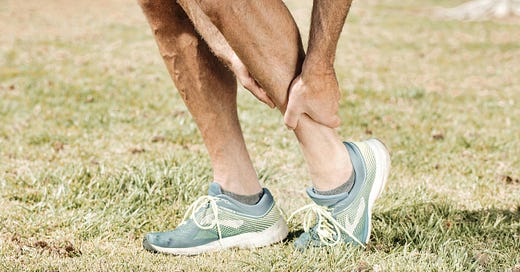The illusion of invincibility
Durant, Haliburton, and the Achilles rupture déjà vu that never should have been
On June 10th, 2019, I tuned in to watch Game 5 of the NBA Finals. The big news that day was that after suffering a calf strain earlier in the playoffs, Kevin Durant was back in the lineup, ready to help the Golden State Warriors come back from a 3-1 series deficit against the Toronto Raptors and cement their dynasty with a three-peat and their fourth title in fifth years.
This postseason run was particularly memorable for me because I was recovering from a torn Achilles tendon. In late February of that year, I had been shooting around in the gym, and when I pushed off, I heard a pop and did the signature look-over-your-shoulder-to-see-who-just-threw-a-baseball-at-your-ankle-only-to-realize-it’s-a-non-contact-injury-and-oh-shit-you-definitely-just-tore-your-Achilles. I had surgery about a week later, and in June, I was still waking up at 5 AM to start my two-a-day rehab exercises to try to get back to full strength.
So imagine my surprise when ABC showed Durant, who was already 30 years old at the time, dancing in the pregame huddle with his newly healed calf. “Does this dude want to tear his Achilles?” I remember thinking. But of course, the Warriors’ star forward had been cleared by medical professionals, so presumably he knew what he was doing.
Or maybe not.
KD did go on to suffer an injury to his Achilles tendon in that game. Later that summer, he would leave the Warriors and sign a contract worth over $160 million with the Brooklyn Nets.
Durant and I would forever be linked as survivors of the 2019 Achilles Tendon Rupture Club. But unlike me, he would be getting paid $40 million during the first year of his recovery.
Over the last six years, Durant remains the reference point when an NBA player suffers an Achilles tendon injury. You’ll see posts on fan blogs like “Kevin Durant is proof that this isn’t the end for Jayson Tatum.”
I can understand this logic. When a player suffers what used to be considered a career-ending injury, most people want to feel optimism. Durant is easily the best-case scenario for someone who has recovered from an Achilles rupture. At 36, he is still averaging over 26 points per game with better than 50-40-80 splits, and he makes over $50 million a year. And yesterday, on the final day of the NBA season, Durant was traded to the Houston Rockets, and his new squad rose to second in bettors’ estimations of who will be the 2025-26 NBA champion.
So perhaps it’s no surprise that, with Durant as a signpost and with a ring hanging in the balance, Tyrese Haliburton chose to play in Games 6 and 7 of the NBA Finals despite suffering a calf strain. We expect our athletes to be gladiators, and those who sit out with injuries at big moments in their careers are frequently lambasted by fans. And could Haliburton have forgotten that he was named the “most overrated” player in The Athletic’s 2025 anonymous player poll?
But if you were to look at my left calf, which seems to measure about half the circumference of my right calf despite almost a full year of intense rehabilitation and six years of “recovery,” you would never have let Haliburton play. Modern surgical methods and advancements in sports medicine have their benefits, but an Achilles tendon rupture is still a significant setback for a basketball player, and a return to pre-injury levels is highly improbable.
Unlike Durant, Haliburton’s game is built on speed and explosiveness. When he returns, he won’t lose his court vision, and hopefully he’ll continue to have that awkward-yet-lethal three-point shot. But there is almost no chance that he’ll be as effective running a high-octane transition offense. In stepping up to try to be the Game 7 superhero for the Indiana Pacers, Haliburton may instead have hampered his chances at becoming a franchise legend.
Next year, the NBA season will kick off without Haliburton, Tatum, and Damian Lillard, all of whom suffered Achilles tendon ruptures in the 2025 playoffs. Three fanbases will tune out from games they otherwise would have watched because, in at least of two of those three cases, players were cleared after suffering significant health issues with their calf muscles. The league and the players’ association need to take a hard look at return-to-play protocols surrounding such cases and evaluate whether the current system is serving the best interests of players, teams, and their fans.
As much as I enjoy watching Kevin Durant defy the odds and drain jumpers like he’ll never retire, he can no longer be the poster child for what an NBA career after recovering from a torn Achilles tendon looks like. People keep saying that #35 is in a class all of his own. Let’s start thinking that way the next time a player wants to come back too soon from a calf injury.




I definitely thought of you when that happened yesterday…